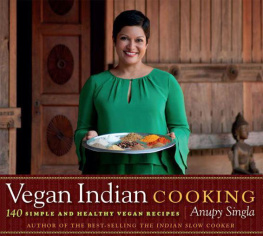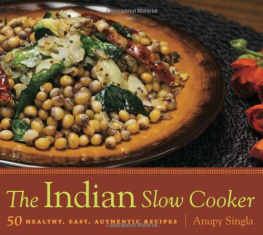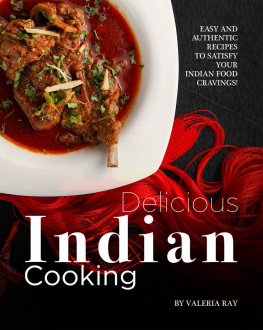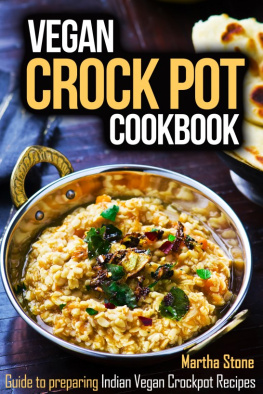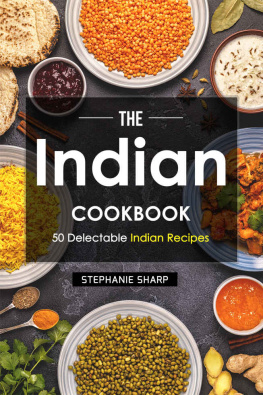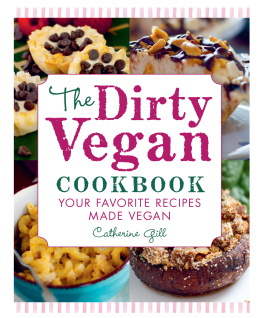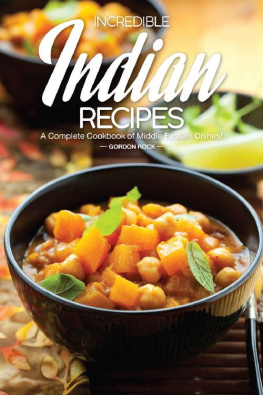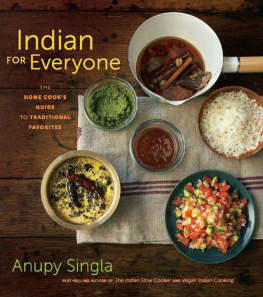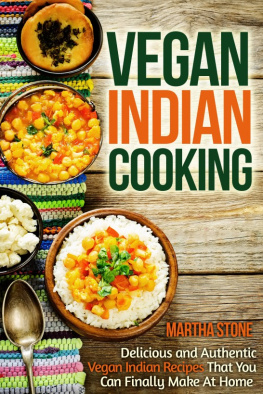Vegan Indian COOKING

Copyright 2012 Anupy Singla
All rights reserved. No part of this book may be reproduced or transmitted in any form or by any means, electronic or mechanical, including photocopying, recording, or by any information storage and retrieval system, without express written permission from the publisher.
First Printing June 2012
Ebook ISBN 978-1-57284-702-6
All photographs copyright Brave New Pictures.
Design by Brandtner Design.
12 13 14 15
Surrey Books is an imprint of Agate Publishing. Agate books are available in bulk at discount prices. For more information, go to agatepublishing.com.
This is for Neha and Aria, my beautiful girls
who are truly fearless in the kitchen.
Contents


B EFORE I TELL YOU WHAT THIS BOOK IS, I WANT TO TELL YOU WHAT IT ISNT. ITS NOT a book that forces a lifestyle upon you. Its not a book that tells you what you should be eating on any given day. And its most certainly not a book that insists I have all the answers. This is a book that tells you, Eat what you want, but make sure what you eat is real, whole food. And open your mind to all of the possibilities.
This book is about those possibilities. The possibility of giving up meat for a meal, a day, a week, or a lifetimewhatever you choose. I grew up eating this way. My mother is a vegetarian who doesnt even eat eggs, but my father eats meat. In our home, we followed an Indian dietwhich is predominantly vegetarianmost days. The only time wed have meat would be for parties, when my mother would make chicken breast smothered in barbecue sauce, or when wed make a rare run to a fast-food restaurant.
The way we ate then is the way a vast number of people still eat in India, where about 30 percent of the countrys sizable population is vegetarianprimarily Hindus, Buddhists, and Jains. Most Muslims eat meat, just not pork; similarly, Hindus refrain from eating beef for religious reasons. (In India, even McDonalds is sensitive to local dietary restrictions and serves lamb burgers.)
This preference for vegetarian cuisine often has nothing to do with dairy products, a mainstay in Indian culture and cuisine. Thus, most Indians are lacto (milk) vegetarians. In my husbands childhood home (as in many households where meat is consumed), one day each week is observed as a holy day when no meat is eaten. On that day, his family would get their protein from paneer, a homemade cheese made from cows milk. To this day, Tuesday is my husbands day to sit down to a meal of peas and homemade cheese (mattar paneer).
I first began my journey following a predominantly vegan diet (meaning no meat or dairy) back in the mid-1990s, when I was a graduate student at the EastWest Center and the University of Hawaii. I fell ill with walking pneumonia and found that I had no energy. My immune system was shot. I went to see a naturopath, who suggested I give up milk, cheese, meat, and seafood for a period of six months so I could cleanse my system and better assess any possible food allergies.
Giving up the meat and seafood wasnt hard, but giving up dairy, on which I had been raised, was a challenge. I began to incorporate more soy milk and tofu into my diet, which wasnt a stretch because I already had grown to love both during the time I lived in Japan.

I quickly began to feel better and more energized, and I rarely got colds. I just felt healthier. I continued with this lifestyle change, but most importantly, I reverted to eating the foods my mother used to make when I was growing up in Pennsylvania: rice, beans, lentils, and lots of fresh vegetables. Mom was a true pioneer, one of the first Indians in America to use a slow cooker to make Indian food way back in the 1970s. I purchased a slow cooker and began to make all the Indian recipes she had developed in her slow cooker over the years.
The move to a vegan diet was relatively simple for me and made sense at the time, particularly since I personally do not like the taste of meat. Of course, that doesnt mean that your journey will be the same as mine. But I hope recipes from this book will encourage you to start thinking about incorporating more plant-based foods and simple, whole-food recipes into your daily diet.
I hope to fulfill two goals with this book. The first is to present you with everyday Indian recipes that are traditionally vegan. My Crackling Okra (see recipe on ) are just a few examples. If you grew up in a South Asian home, youll recognize these recipes instantly, but some have my own twist on the traditional preparation. Ive never cooked from an Indian cookbook, and Ive only lately started using them as quick references as I write my own books. All of my experience cooking and eating Indian food comes from my own family (a bunch of foodies from Punjab) and my experiments working and studying in various home kitchens over the years.
My second goal is to give us South Asians a new way to think about the foods we grew up with. Just as in the West, life moves faster in Asia today, including India. As more and more women rightly enter the workforce, we have less time to cook the way our grandmothers and mothers did before us. (Thats not to say men dont have a place in the kitchen. My grandfather directed the menu for our family in India.) We are all desperately seeking shortcuts that preserve our sanity and get food on the table. In Indian grocery stores in India and beyond its borders, youll find prepackaged spice blends and food mixes, jarred chutneys, and frozen foods. You can easily stop at mainstream grocers and pick up a pouch of prepared Indian food and a bag of naan for a quick and seemingly healthy dinner for the family.

Always remember, though, that convenience has a price. These foods cook faster and are easier to prepare largely because they are processed and stripped of a majority of their nutrients to give you the quick dinner solution your mind, but not your body, craves. It might seem like its always been the caseeven in Indiathat Indian food is consumed with light, fluffy breads made from white flour and dishes concocted with premade spice mixtures. But its simply not so. My mother still remembers her mother grinding whole wheat kernels into flour that would go into the hearty dinner rotis and roasting and grinding her own garam masala blend.
I want to preserve this history of whole-grain, wholesome cooking and add a new twist of convenience. In these pages, Ill show you how you can get the same level of nutrition and the same traditional flavors without a ton of added time and effort. Instead of using white rice to make tamarind rice, Ive successfully made it with wholesome brown rice and even quinoa. Instead of giving you options for making naan (a type of leavened Indian bread typically made from processed white flour), Ill show you how to make roti, the whole-wheat bread thats really consumed on a daily basis in North Indian homes. Dosas pack a real nutritious punch when they are made with brown rice and whole lentils instead of white rice and split and skinned lentils. Believe it or not, my kids actually request these whole-grain
Next page
